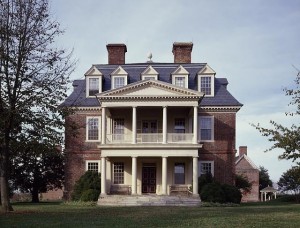Visiting the Past and the Places in Between: Buildings and Landscapes as Historical Documents
In 1953, L.P. Hartley wrote that “The past is a foreign country: they do things differently there.” Historians and lay readers alike are familiar with the idea that the past is a different place, but often lose sight of the word “place” in that discussion. Like any other place, we can travel to the past. Most often, we do this through the written word. We read primary sources that introduce us to foreign cultures and practices that once existed in the very location (sometimes down to the exact longitude and latitude) we do today, albeit in a place—a historical context encompassing geography, culture, and more—that would be utterly alien.

Manor home of Shirley Plantation, Virginia’s oldest plantation, founded in 1613 in Charles City, Virginia. In her research, Holmes compares the evolution of the plantation house in Virginia, South Carolina, and Barbados. Credit: Library of Congress
“Visiting the Past and the Places in Between” is based on my belief that history is inherently place-based and that historical analysis is strengthened by comparison. We attach ourselves (to varying degrees) to the places we come from, the places we live, and the places to which we travel. Among the richest resources for historians of the early modern period seeking thick descriptions of long lost people and places are travel narratives. These accounts are fundamentally the product of comparing the familiar with the unfamiliar, and to some extent historians produce our research questions from the same cloth. Pairing travel narratives with existing (or archaeological) historic structures, as well as expanding the definition of a “historical document” to include landscapes and buildings, provides an entry point to the past that can allow us to not only answer those questions, but to push them further.
My dissertation, for example, is a comparative study of plantation landscapes in Virginia, South Carolina, and Barbados during the 18th century that uses material culture, architectural history, and archaeology to access lost landscapes. I argue that the evolution of the plantation house in these three colonies reveals how slavery was the key factor in turning British colonists in Virginia and South Carolina into American citizens, in contrast to Barbados where, despite a much larger population of enslaved individuals, the persistence of a 17th-century built environment reinforced Barbadian planters’ Englishness. To do this, not only do I draw on the documentary record through travel narratives, correspondence, household accounts, probate inventories, etc., but I examine buildings and landscapes from the period and how they changed over time, all to consider how individuals shaped (and were shaped) by the spaces they occupied.

Hampton Plantation in McClellanville, South Carolina. Photo Credit: Erin Holmes
This summer, I invite AHA Today readers to join me as I travel to some of the places I study—first in Barbados, then in South Carolina, and finally in Virginia—to explore how modern people can “read” both an existing modern landscape and a lost landscape from the past. I’ll examine some historical narratives to situate these modern places (and their historic structures) within their historical context, demonstrating how historical actors’ experiences within these tangible spaces influenced their understanding of the societies and cultures in which they lived. I’ll also consider how people in different places remember the past and use it to change the present, most immediately at the historic sites I explore, but sometimes more broadly. I hope that my blog series will encourage historians to expand their definition of what constitutes a historical document. In reading landscapes and buildings in less formal ways, and in avoiding the jargon that often makes writing about material culture, architecture, and archaeology impenetrable, I hope to demonstrate how other historians can use these methodologies in their own work.
Visiting the past as a historian can be as straightforward as following the journey or narrative of some historical actor or it can require stopping over at “the places in between”: historic houses, museums, archives, or archaeological sites. These sites help us anchor our narratives whether we’re writing a book, teaching a class, or leading a tour. The past is another land, and they do do things differently there, but it is definitely not beyond our reach—especially with a good map and a guide.
This post first appeared on AHA Today.
Tags: AHA Today Perspectives Summer Columns
Comment
Please read our commenting and letters policy before submitting.






